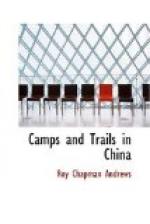There were certain trails leading over the hill slopes at Hui-yao which the gorals must have used continually, judging by the way in which these were worn. We also found much sign beneath overhanging rocks and on projecting ledges to indicate that these were definite resorts for numbers of the animals. Many which we saw were young or of varying ages running with the herds, and it was interesting to see how perfectly they had mastered the art of self-concealment even when hardly a year old. Although at Hui-yao almost all were on the east side of the river, they did not seem to be especially averse to water, and several times I watched wounded animals swim across the stream.
Gorals are splendid game animals, for the plucky little brutes inspire the sportsman with admiration, besides leading him over peaks which try his nerve to the utmost, and I number among the happiest hours of my life the wonderful hunts in Yuen-nan, far above the clouds, at the edge of the snow.
CHAPTER XVIII
THE “WHITE WATER”
Y.B.A.
October had slipped into November when we left the temple and shifted camp to the other side of the Snow Mountain at the “White Water.” It was a brilliant day and the ride up the valley could not have been more beautiful. Crossing the gangheisa or “dry sea,” a great grassy plain which was evidently a dry lake basin, we followed the trail into the forest and down the side of a deep canon to a mountain stream where the waters spread themselves in a thin, green veil over a bed of white stones.
We pitched our tents on a broad terrace beside the stream at the edge of the spruce forest. Above us towered the highest peak of the mountain, with a glacier nestling in a basin near its summit, and the snow-covered slopes extending in a glorious shining crescent about our camp. The moon was full, and each night as we sat at dinner before the fire, the ragged peaks turned crimson in the afterglow of the sun, and changed to purest silver at the touch of the white moonlight. We have had many camps in many lands but none more beautiful than the one at the “White Water.”




